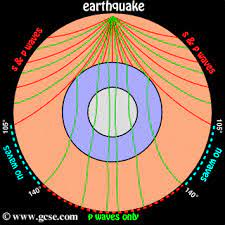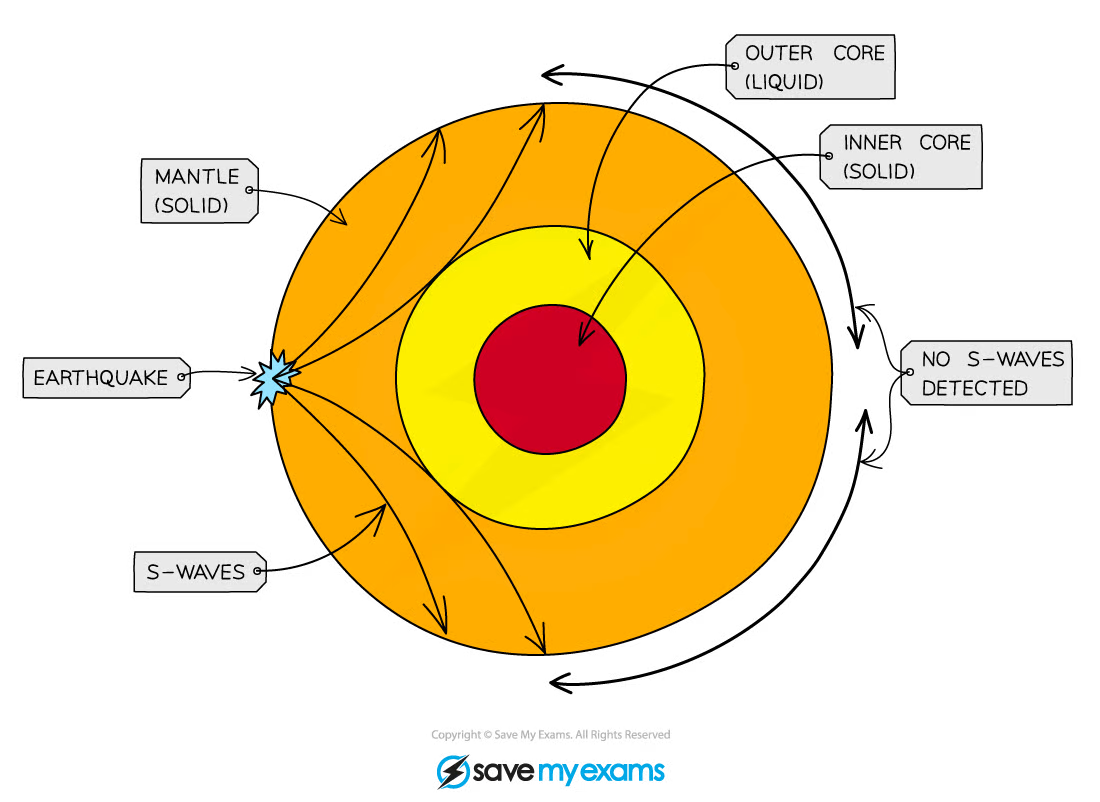
Exploring Structures Using Waves
Waves can be used to detect and explore
Waves have different properties, e.g. speed, depending on the material they’re travelling through
When a wave arrives at a boundary between materials, a number of things can happen:
It can be completely reflected or partially reflected(like in ultrasound imaging). The wave may continue travelling in the same direction but at a different speed, or it may be refracted or absorbed.
Studying the properties and paths of waves through structures can give you clues to some of the properties of the structure that you can’t see by eye. You can do this with lots of different waves-ultrasound and seismic waves are two good, well-known examples
Earthquakes and explosions cause seismic waves
When there’s an earthquake somewhere, it produces seismic waves which travel out through the Earth. We detect these waves all over the surface if the planet using seismometers.
Seismologists work out the time it takes for the shock waves to reach each seismometer. They also note which parts of the Earth don’t receive the shock waves at all.
When seismic waves reach a boundary between different layers of material(which all have different properties, like density) inside the Earth, some waves will be absorbed and some will be refracted.
Most of the time, if the waves are refracted they change speed gradually, resulting in a curved path. But when the properties change suddenly, the wave speed changes abruptly, and the path has a kink.
P-waves can travel through the Earth’s core, S-waves can’t
There are two different types of seismic waves you need to learn-P waves and S waves
By observing how seismic waves are absorbed and refracted, scientists have been able to work out where the properties of the Earth change dramatically. Our current understanding of the internal structure of the Earth and the size of the Earth’s core is based on these observations.
P-waves inside the Earth  P-waves are longitudinal
P-waves are longitudinal
They travel through solids and liquids
They travel faster than S-waves
S-waves inside the Earth 
S-wave are transverse
They can’t travel through liquids or gases
They’re slower than P-waves
Exploring Structures Using Waves
Waves can be used to detect and explore
Waves have different properties, e.g. speed, depending on the material they’re travelling through
When a wave arrives at a boundary between materials, a number of things can happen:
It can be completely reflected or partially reflected(like in ultrasound imaging). The wave may continue travelling in the same direction but at a different speed, or it may be refracted or absorbed.
Studying the properties and paths of waves through structures can give you clues to some of the properties of the structure that you can’t see by eye. You can do this with lots of different waves-ultrasound and seismic waves are two good, well-known examples
Earthquakes and explosions cause seismic waves
When there’s an earthquake somewhere, it produces seismic waves which travel out through the Earth. We detect these waves all over the surface if the planet using seismometers.
Seismologists work out the time it takes for the shock waves to reach each seismometer. They also note which parts of the Earth don’t receive the shock waves at all.
When seismic waves reach a boundary between different layers of material(which all have different properties, like density) inside the Earth, some waves will be absorbed and some will be refracted.
Most of the time, if the waves are refracted they change speed gradually, resulting in a curved path. But when the properties change suddenly, the wave speed changes abruptly, and the path has a kink.
P-waves can travel through the Earth’s core, S-waves can’t
There are two different types of seismic waves you need to learn-P waves and S waves
By observing how seismic waves are absorbed and refracted, scientists have been able to work out where the properties of the Earth change dramatically. Our current understanding of the internal structure of the Earth and the size of the Earth’s core is based on these observations.
P-waves inside the Earth  P-waves are longitudinal
P-waves are longitudinal
They travel through solids and liquids
They travel faster than S-waves
S-waves inside the Earth 
S-wave are transverse
They can’t travel through liquids or gases
They’re slower than P-waves
 Knowt
Knowt